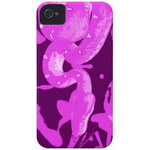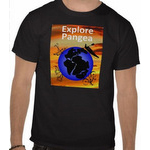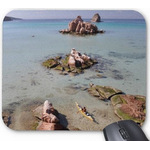Download GPS files for Blue Mountain Canyons:
• GPS track
Photo album:
• Blue Mountains Canyons
Canyoneering in the Blue Mountains
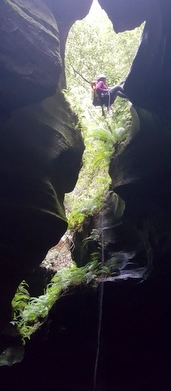 Sonny and Calius, our teammates from our search and rescue team have organized a canyoneering trip in the Blue Mountains National Park in Australia. As we are close (...), we join them. So we take a riding break, leave the bikes in a bike shop in Auckland to repair a few things and fly to Sydney.
Sonny and Calius, our teammates from our search and rescue team have organized a canyoneering trip in the Blue Mountains National Park in Australia. As we are close (...), we join them. So we take a riding break, leave the bikes in a bike shop in Auckland to repair a few things and fly to Sydney.
We meet Sonny and Calius at the Sydney airport and head to Tim's house, where we stay for a few days. That same afternoon he takes us down an easy and short canyon with a slightly exaggerated name: Grand Canyon. It has very little difficulty, but it serves as an introduction to the Blue Mountains canyons: exuberant vegetation in the hike in and out, ferns hanging on the canyon walls and best of all: water dragons!
Water dragons are prehistoric looking lizards that surprisingly live in the canyons. The walls of the Grand Canyon are not too high, however, the sun only reaches the bottom of the canyon for a few hours a day. Also, the water is cold. So it seems a habitat not suitable for these reptiles. But there it is, our first water dragon, almost one meter long, with a pointy crest from the back of the head to the base of the tail. When he feels threatened by some humans with clinking metal gadgets hanging from their waists, he jumps into the water. While submerging under a rock, we can see how swiftly it swims with sinusoidal movements of its muscular tail.
This canyon is really simple technically speaking. It does not even require a wetsuit. It only has one rappel but is good as a reminder for an activity that we had not practiced in months.
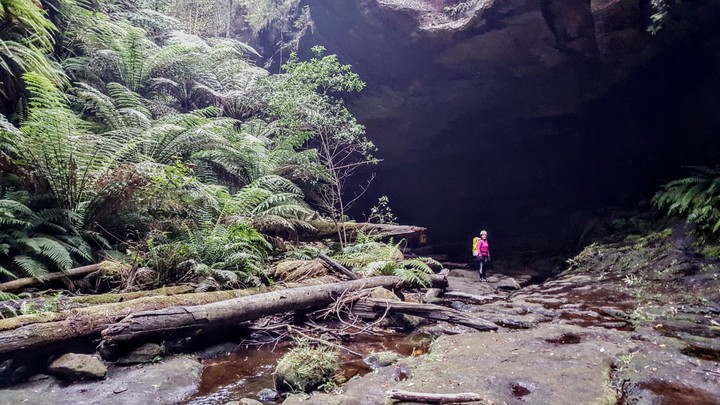
Claustral is the name of our second canyon. It is the most famous in the area for its spectacular beauty and variety. It has a few rappels without too much difficulty, but it requires a wetsuit as much for the water temperature as for how aquatic it is. One of the rappels is so awkward that you have to go through a natural arch excavated in the sandstone rock by the force of the water. The walls of the canyon are covered with moss and where it widens enough for the light to reach, with ferns forming natural hanging gardens. The exits of the narrowest sections are really beautiful. As we approach the wider area, the fractal fronds details begin to appear. In addition, the sky is cloudy today and the light that penetrates through the rain forest up on the canyon rims, is very soft, without glare. It almost seems to fall slowly like a mist that illuminates the beauty of the place.

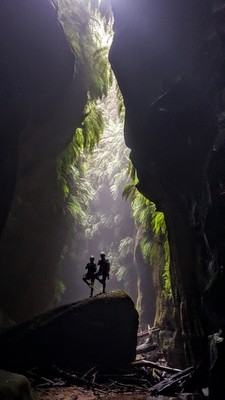 The water is really cold. We had forgotten the frigid chills down the spine when you get water inside the neoprene suit in the sections that you have to swim. It's like you throw a bunch of ice cubes down your neck. With the swimming strokes, the wet suit leaves openings in the neck where the water sneaks in. First is a trickle that makes you arch your back, as if you wanted to separate it from the wet suit. Then comes the worst. Icy water runs down the back until it reaches your kidneys. It took so long to warm up the water film between the wet suit and the skin! At that point, you are already in a pre-shock state. Your movements to keep swimming downstream are not very harmonious and quite convulsive. At that moment, there is no time to enjoy the magnificence of the environment and the only thing that worries you is to reach the end of the pool and get out of the water.
The water is really cold. We had forgotten the frigid chills down the spine when you get water inside the neoprene suit in the sections that you have to swim. It's like you throw a bunch of ice cubes down your neck. With the swimming strokes, the wet suit leaves openings in the neck where the water sneaks in. First is a trickle that makes you arch your back, as if you wanted to separate it from the wet suit. Then comes the worst. Icy water runs down the back until it reaches your kidneys. It took so long to warm up the water film between the wet suit and the skin! At that point, you are already in a pre-shock state. Your movements to keep swimming downstream are not very harmonious and quite convulsive. At that moment, there is no time to enjoy the magnificence of the environment and the only thing that worries you is to reach the end of the pool and get out of the water.
About halfway down the canyon, we stop for lunch at the only sandy beach in the canyon, where a tributary joins. According to the locals that guide us, going up the tributary, we could reach a dark area where glow worms can be seen. After lunch, we rush upstream with enthusiasm, but the desire freezes after the first bend when we realize that there is a long wade. Our mothers always told us that we could not swim in cold water until we completed the digestion, so as good kids, we go back to the beach.
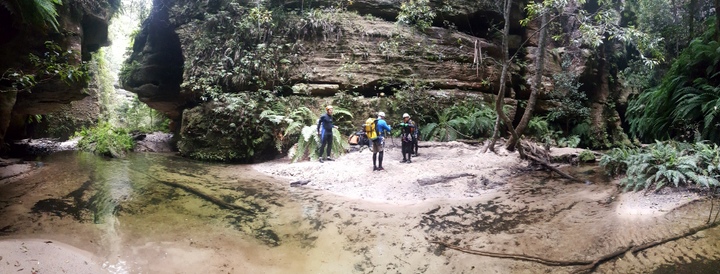
The canyon exit is via a gully so steep that we have to climb grabbing roots and rocks with our hands, with a backpack full of gear on our backs. The worst part is that everything we are carrying is wet and the water drips during the rest of the hike out. It is like the Malay drop torture. You may be wondering why a half-intelligent person likes all that suffering. If you know the answer, please tell us.
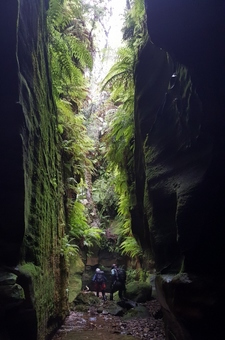 On the morning of our third day in the Blue Mountains, Judit wakes up with a terrible headache and stays home with Calius. Sonny and Cèsar are going to the Whungee Whengee canyon with Tim and a few of his teammates from his canyoneering club. After a fairly long approach, we start with a first rappel that ends in the water. The first section consists of walking through the riverbed between giant ferns and all kinds of vegetation unknown to us. In this canyon there are many "yabbies", a bright orange crayfish, pretty but bad for camouflage. Unfortunately they are protected, like all the fauna and flora in the park, because to me, the first word that comes to my mind when I see them is paella.
On the morning of our third day in the Blue Mountains, Judit wakes up with a terrible headache and stays home with Calius. Sonny and Cèsar are going to the Whungee Whengee canyon with Tim and a few of his teammates from his canyoneering club. After a fairly long approach, we start with a first rappel that ends in the water. The first section consists of walking through the riverbed between giant ferns and all kinds of vegetation unknown to us. In this canyon there are many "yabbies", a bright orange crayfish, pretty but bad for camouflage. Unfortunately they are protected, like all the fauna and flora in the park, because to me, the first word that comes to my mind when I see them is paella.
The next section of the canyon is a lot of fun. It’s a rock chaos with giant chunks of rock where we have to negotiate a way through to continue downstream. Sometimes you have to climb up and rappel to go back down to the riverbed. Other times you have to go under. Luckily, today´s flow is low enough not to form any siphon. In the tightest passage there is still a few inches air gap between the water surface and the rock above. So we do not have to hold our breath at any point.
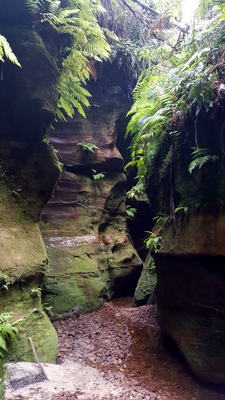 In an easy down climb, one of those where your drag your butt on a flat ledge, Cèsar’s foot gets stuck in a little crack while his rear continues down. His knee twists and one of his ligaments makes a disturbing crunch. It doesn’t seem to be broken and luckily the joint continues to have stability. The compression of the wetsuit and the cold water prevent the inflammation, but Cèsar continues the canyon limping. Sonny takes some of the gear in his backpack to lighten the weight. After the long trail back to the vehicles, it’s clear that his knee needs rest and that the canyon season is over for him.
In an easy down climb, one of those where your drag your butt on a flat ledge, Cèsar’s foot gets stuck in a little crack while his rear continues down. His knee twists and one of his ligaments makes a disturbing crunch. It doesn’t seem to be broken and luckily the joint continues to have stability. The compression of the wetsuit and the cold water prevent the inflammation, but Cèsar continues the canyon limping. Sonny takes some of the gear in his backpack to lighten the weight. After the long trail back to the vehicles, it’s clear that his knee needs rest and that the canyon season is over for him.
This unfortunate event disrupts our plans in Australia. We spend the rest of the days until our flight back to New Zealand doing some tourism and short limping walks. Probably the best visit is the Jebolan caves. The guided tours go through several of the caves showing the best formations: stalactites, stalagmites, columns, drapes with colored bands, walls covered with sparkling crystals... We also have agreat dinner, the one we cook in an AirBnB inside a vineyard to celebrate the Judit's birthday. We drive around hundreds of kilometers looking for kangaroos but we see none. We would settle for a wallaby, but not even that. Forget about wombats and platypuses. In the end we have to give up and visit a zoo dedicated to Australian species. Very educational, but it's a dilemma to see them in captivity.
After a week the knee is far from ready for pedaling so, we fly to Barcelona to spend Christmas with our families. There Cèsar meets his college friend Joan, now a traumatologist. His diagnostic is confirmed by the MRI scan: partial rupture of the inner lateral ligament. The treatment: 4 to 8 weeks of rest. While the muscles weaken, the belly grows due to the abundant Mediterranean delicacies. That's what the holidays are for. We will start the diet after New Year´s day.
